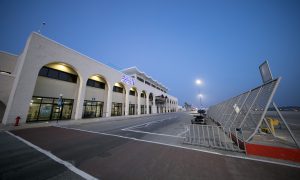Torri Xutu: From under the command of the Torriero to under the watch of the Coast Police
Dotting the Maltese islands are some 27 watchtowers, strategically placed to provide the archipelago with a robust defence system during the time of the knights. While some of the original structures were either demolished or collapsed after falling into disuse, many of them have stood the test of time and the fury of the elements to become iconic features of the Maltese coastal landscape. Looking out in Filfla’s direction in Wied iż-Żurrieq is one of these structures; Ta’ Xutu Tower, which was recently restored by Din l-Art Ħelwa with the support of The Malta Airport Foundation. Whilst restoration works have been completed, The Malta Airport Foundation is working towards getting the necessary permits to carry out landscaping works around the tower, with the aim of turning the surrounding area into a well-kept open space.

To learn more about these watchtowers, we spoke with Dr Stanely Farrugia Randon. A doctor by profession with a penchant for researching about Malta’s environmental and cultural history, Dr Farrugia Randon has been a council member of Din l-Art Ħelwa for the past 26 years, during which he has been involved actively in the mangement of restoration projects.

Q. Having been built by five Grand Masters, namely Wignacourt, De Redin, Lascaris, Cotoner and Perellos, do the different towers bear the ‘structural hallmarks’ of the Grand Master who built them?
A. Even the towers that are very similar in appearance, have internal and external differences, which probably reflect the preferences of the Grand Master or the architects involved in their construction. The majority of the small coastal towers are set on two floors, with the lower one having been used for ammunition and the upper one having accommodated the soldiers on duty. Towers such as Wignacourt in St Paul’s Bay also house a kitchen and a toilet, and towers including San Luċjan, St Agatha and St Thomas are bigger and even more complex, having large cisterns to store water for bigger troops positioned within them for long periods when the island would be under siege.
Q. Were these towers manned on a 24-hour basis, and by whom were they manned?
A. All of these watchtowers had to be guarded and armed, both during the day and in the nighttime, in preparation for the eventuality of an enemy fleet attempting disembarkation. Whilst the Grand Masters and the knights donated money for the running of these look-out posts, and affixed their coats of arms to the buildings, it was the Maltese who guarded them. The number of guards deployed depended on the location and the size of the tower. A bombardier who was trained in firing cannons would be present, especially during difficult times, and very often there would also be a Torriero, who was considered to be the commander of the place. However, in reality, often there would not be enough men to guard each post, leading to the abandonment of some of the towers soon after their construction.
Q. Ta’ Xutu was the first tower to have vaulted ceilings instead of wooden beams. Why was there a shift towards this type of ceiling in the construction of these towers?
A. Small coastal towers such as the ones in Ġnejna (Lippija Tower), Qawra, St George’s Bay and Għajn Tuffieħa were built during the reign of Grand Master Lascaris with roofs that were not robust enough to carry the weight of a cannon and withstand its recoil. Whilst Ta’ Xutu was also built under Lascaris’s reign, its vaulted upper floor furnished it with enough structural sturdiness to have a cannon on its roof, essentially enabling the tower to defend itself and act as a relay station signalling enemy approach. This structure was a success, so much so that Ta’ Xutu served as the prototype of the towers that were built by Lascaris’s successor; De Redin. It is interesting to note that whilst Lascaris’s towers were paid for out of the people’s taxes, De Redin paid for the construction and woodwork of his 13 towers himself; a total that amounted to slightly over 6428 scudi.

Q. Ta’ Xutu went on to be used during the second World War. Was the tower’s role during this time different from its original function?
A. During this time, the tower was used as a coast observation post, and was manned by the Coast Police. Ta’ Xutu was, in fact, used as a police station until 2002, when it was abandoned. During the time of the war, most of the watchtowers were used by military or naval authorities.




